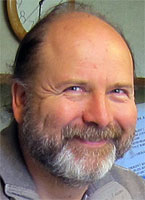 Over at Edge, Aalam Wassef, Clay Shirky , Gloria Origgi, George Church, Noga Arikha, Douglas Rushkoff , George Dyson, Simona Morini answer W. Daniel Hillis's Question:
Over at Edge, Aalam Wassef, Clay Shirky , Gloria Origgi, George Church, Noga Arikha, Douglas Rushkoff , George Dyson, Simona Morini answer W. Daniel Hillis's Question:
The question of secrecy in the information age is clearly a deep social (and mathematical) problem, and well worth paying attention to.
When does my right to privacy trump your need for security?; Should a democratic government be allowed to practice secret diplomacy? Would we rather live in a world with guaranteed privacy or a world in which there are no secrets? If the answer is somewhere in between, how do we draw the line?
I am interested in hearing what the Edge community has to say in this regard that's new and original, and goes beyond the political. Here's my question:
WHO GETS TO KEEP SECRETS?
Clay Shirky:
Social & Technology Network Topology Researcher; Adjunct Professor, NYU Graduate School of Interactive Telecommunications Program (ITP); Author, Here Comes Everybody
“When does my right to privacy trump your need for security?” seems analogous to the question “What is fair use?”, to which the answer is “Whatever activities don't get people convicted for violating fair use.” Put another way, fair use is a legal defense rather than a recipe.
Like fair use, the tension between a right to privacy and a right to know isn't one-dimensional — there are many independent variables involved. For instance, does the matter at hand involve elected or appointed officials? Working in the public name? The presumption should run to public review.
Does it involve private citizens? Would its release subject someone to harassment or other forms of attack? The presumption should run to privacy. And so on.
There are a set of clear cases. Congress should debate matters openly. The President should have a private channel with which to communicate with other world leaders. Restaurants must publish the results of their latest health inspection. You shouldn't have your lifetime browsing history published by Google. These are not complicated cases.
The complicated cases are where our deeply held beliefs clash. Should all diplomats have the right to all communications being classified as secret? Should all private individuals be asked, one at a time, how they feel about having their house photographed by Google?
“Our study offers compelling evidence that it is the social aspects of religion rather than theology or spirituality that leads to life satisfaction,” said Chaeyoon Lim, an assistant professor of sociology at the University of Wisconsin-Madison, who led the study. “In particular, we find that friendships built in religious congregations are the secret ingredient in religion that makes people happier.” In their study, “Religion, Social Networks, and Life Satisfaction,” Lim and co-author Robert D. Putnam, the Malkin Professor of Public Policy at Harvard University, use data from the Faith Matters Study, a panel survey of a representative sample of U.S. adults in 2006 and 2007. The panel survey was discussed in detail in the recently published book American Grace by Putnam and David E. Campbell.
